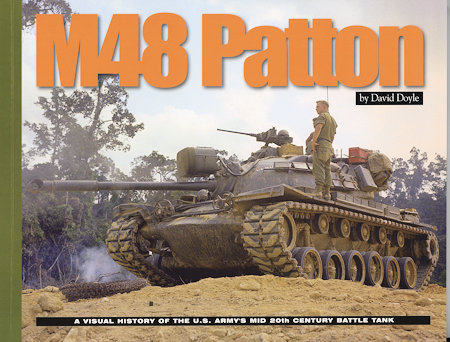Ampersand's M48 Patton
|
BY: |
David Doyle |
|
PUBLISHER
/PRICE: |
Ampersand
$22.95 |
|
REVIEW BY: |
Scott
Van Aken |
| NOTES: |
120 pages, softcover, landscape, ISBN 978-0-9861127-6-8 |
 The Patton tank
was a development of the M 26 Pershing and went through a number of changes
during its long life, eventually becoming the basis of the M60 series of tanks.
Both Pattons and M60s are still being operated by some militaries around the
world, a testament to the correctness of the design and the usefulness of the
tank.
The Patton tank
was a development of the M 26 Pershing and went through a number of changes
during its long life, eventually becoming the basis of the M60 series of tanks.
Both Pattons and M60s are still being operated by some militaries around the
world, a testament to the correctness of the design and the usefulness of the
tank.
Originally developed as the M46 and later
the M47, the M48 combined the improvements of those two tanks into one system.
Such was the need for the tank, that it was ordered into production during the
Korean War without going through the often rigorous and time consuming testing
that is the norm for weapons systems like this. Of course, since the tank was
based on proven systems, it really wasn't that much of a leap of faith, but it
was unusual.
The initial Pattons were still called the
T-48 during the first 1,000 vehicles, but eventually it was designated the M48.
This tank was powered by a gasoline engine and lacked the distinctive machine
gun cupola of later variants. The M48A1 added this feature and still used the
90mm gun, though it was becoming obvious that something larger was going to be
needed. The M48A2 reduced the number of return rollers and the A2C did away with
the small tensioner wheel just below the sprocket. It also swapped out the
gasoline engine for a diesel producing the higher rear deck. A flame thrower
variant was the M67, built in small numbers.
As with every tank, modifications
continued and earlier versions were rebuilt as the M48A3. These tanks received
the diesel engine from the M60 and other equipment upgrades. The A4 version was
only built in prototypes and the M48A5 was when the tank finally got a 105mm gun
along with a lower profile turret.
In line with other titles of the visual
history series, this one is primarily a photo book and most of those photos are
of extant vehicles. Fortunately, pretty much all the variants exist in museums
somewhere in the US and these are fairly well preserved. Those which are the
most complete in terms of equipment are chosen and so we are provided with a
huge number of superbly done color photographs of these tanks. The image
descriptions give us a feel of what equipment these tanks had and how they
changed as time went on.
The book is very much a must have for
anyone who likes to model the tank, so that one can be assured of the accuracy
of their presentation. Fans of the tank who just like reading about it will be
happy with this edition as well. It is a book from which I learned a lot and one
that I can highly recommend to you.
February 2016
Cpyright ModelingMadness.com
Review copy courtesy
Ampersand Publishing.
Get yours today
at this link.
If you would like your product reviewed fairly and
fairly quickly, please contact
the editor or see other details in the
Note to
Contributors.
 The Patton tank
was a development of the M 26 Pershing and went through a number of changes
during its long life, eventually becoming the basis of the M60 series of tanks.
Both Pattons and M60s are still being operated by some militaries around the
world, a testament to the correctness of the design and the usefulness of the
tank.
The Patton tank
was a development of the M 26 Pershing and went through a number of changes
during its long life, eventually becoming the basis of the M60 series of tanks.
Both Pattons and M60s are still being operated by some militaries around the
world, a testament to the correctness of the design and the usefulness of the
tank.